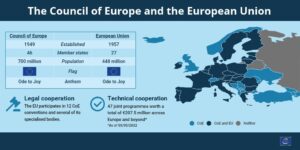The Council of Europe, the “unknown” European institution, crucial for European nature protection
In July 2022, the United Nations recognised that a healthy, and sustainable environment is a human right. The Council of Europe (CoE), the international institution created to promote democracy and protect human rights and the rule of law in Europe, engaged for years to promote European nature and landscape. Its role is now more relevant than ever to guarantee this human right in the continent. Among the 37 States of our EUROPARC members, 36 are members or observers of the Council of Europe. That is why since 2023 the CoE has been a priority of the EUROPARC Brussels’ Office, and why we are publishing a series of articles to present to our members and public the Council of Europe’s work and the EUROPARC commitment as a member of the CoE’s Conference of International Non-Governmental Organisations.
The Council of Europe, the “unknown” European institution, crucial for European nature protection
The Council of Europe was created in 1949, just after the II World War, and today it brings together 46 member states (Russia lost the status of member in 2022). It is based in Strasbourg (FR), its official languages are French and English, and it is a very important and complex institution.
During its long history, the CoE has launched and implemented several initiatives in the sector of “Culture / Cultural Heritage / Nature” that are very crucial for EUROPARC and its members, among which:
- Bern Convention – Convention on the Conservation of European Wildlife and Natural Habitats
- Landscape Convention
- European Heritage Days
- European Diploma of Protected Areas of the Council of Europe
- Landscape Award of the Council of Europe
- Reykjavik Declaration, annex 5
The CoE is also very committed in the Youth involvement, other important topic for EUROPARC.
But… What is the Council of Europe?
This organisation is distinct from the European Union (EU), even if both share the same European flag, the same European anthem, and no country has ever joined the EU without first belonging to the Council of Europe.
As such, it should not be confused with the European Council and the Council of European Union which are EU institutions…

Source: The Council of Europe and the European Union. Available at: coe.int/en/web/portal/european-union.
Already lost? Do not worry, it is normal!
Forget the EU, and just remain concentrated on the Council of Europe. It is the oldest European institution, created to defend human rights and democracy.
The most famous body of CoE is the European Court of Human Rights (ECtHR) which ensures that States respect the European Convention on Human Rights: citizens, and sometimes even States, can appeal to the Court. In the future, this institution could become relevant in case of violations of the right to a healthy environment.
Nevertheless, there are several other CoE bodies that are less known but vital for the CoE’s work. In particular, four institutions composing the so-called CoE “quadrilogue”
- Committee of Ministers
- Parliamentary Assembly (PACE)
- Congress of Local and Regional Authorities
- Conference of International Non-Governmental Organisations (INGOs)
Each of these bodies has a role in the development of environmental protection in Europe.

The Committee of Ministers is the Council of Europe’s decision-making body. It is composed of the Ministers for Foreign Affairs of Member States. Each Member State guarantees the presidency in turn for 6 months. Occasionally, the Council of Europe organizes Summits of the Heads of State and Government, as done in 2023 in Reykjavik, where they adopted the Reykjavík Declaration – United around our values. The Annex 5 of this declaration is devoted to reinforcing the CoE commitment to environmental protection.
Do you know that some members of your national parliaments are also members of the CoE’s Parliamentary Assembly (PACE)? This is indeed the way to guarantee the voice of the representatives elected by citizens inside the CoE. PACE acts as a “motor”, driving forward new ideas and holds a constant dialogue with governments, national parliaments, other international organisations and civil society which “set the agenda”. With the #EnvironmentRightNow: a PACE initiative of the Assembly in 2021, the institutions strongly pushed for the adoption of a healthy environment as a human right.
The Congress of Local and Regional Authorities is a political assembly whose members represent over 150,000 local and regional authorities throughout Europe. It is responsible for strengthening local and regional democracy in its 46 member states. As the voice of Europe’s municipalities and regions, it works to foster consultation and political dialogue between national governments and local and regional authorities, through cooperation with the Committee of Ministers. Clearly, for all our work connected with regional and natural Protected Areas, as well as Periurban parks, this institution could become a relevant interlocutor.
Last but not least, the Conference of International Non-Governmental Organisations (INGOs). Independent non-governmental organisations are a vital component of European society, guaranteeing freedom of expression and association, fundamental for a functioning democracy. International NGOs (INGOs) have therefore the opportunity to acquire CoE participatory status and become a member of the Conference. Since 2016, its role has increased through a stronger dialogue and collaboration with the other 3 institutions of the “quadrilogue”. The Conference of INGOs meets in its General Assembly twice a year and works in Committees on priority themes. EUROPARC is an active member of the Conference, is part of several working groups and led for 2 years the – Environment, Climate Change, Heritage & Health Committee (ECCH&H).
In the next articles, we will start to explore the CoE’s work and commitment to the environment, as well as its relevant Conventions to discover their importance for the European Protected Areas and the role that EUROPARC and its members can play in promoting and implementing them.